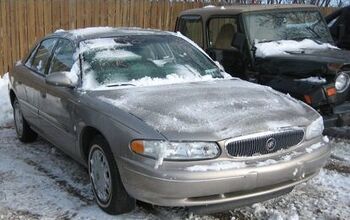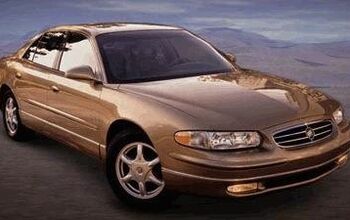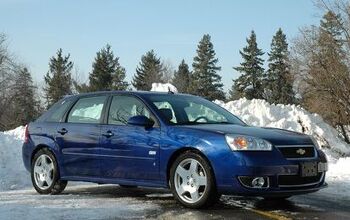Piston Slap: Too Cool, or Dex-Cool?

Nate writes:
Ok, you asked for input and I’ve got a question about my 2003 Cadillac CTS. I figure I’m more likely to get a reliable answer from you and the best & brightest of TTAC than the goof balls at Car Talk (this letter is from February-SM), so I’ll ask.
I bought this CTS back in November. It had 135,000 miles on the odo, came from a private owner and apparently had significant engine work accomplished a year or so ago apparently as a result of a timing belt failure after it wasn’t replaced on schedule. Before being able to get the car licensed, I paid to have the thermostat and temp sensor replaced as I had a CEL and a P0128 code and the car wouldn’t pass inspection with a CEL code. The code came back after just about 1 week.
The CEL will clear if the ambient temps move up above 45-50 degrees but returns when the temps get back down to Utah normals for winter. I’ve been unable to find an online solution. I’ve considered installing a temporary partial radiator block, (cardboard & duct tape) to see if that old school fix brings the temp up. The car doesn’t have a temp gauge- thanks for nothing GM; but seems to warm up the cabin appropriately if not exceptionally fast.
Am I going to have to reset the codes each December before taking this in for emissions inspection or is there a real fix?
Sajeev answers:
Much like LSX swaps for people wanting to make a slow car fast, much like Panther Love for someone wanting a cheap and durable ride, I pretty much always think Dex-Cool is the problem when certain vintage GM products have temperature control problems. As this paragraph shows, Dex-Cool is not my friend…and I am somewhat less goofy than the Car Talk peeps.
On the plus side, others are in your situation and they agree with me. Let’s face it: the timing belt proves that this car was neglected. It’s a safe bet that Dex-Cool was never changed either, possibly topped off with non Dex-Cool compatible fluid too. So there is a TON of the stuff you see in the photo below. And above. So I suspect that the 1 week grace period you mentioned was the time necessary to re-clog that temperature sensor and cause the P0128 to trip yet again.
I’d recommend a closer look at your cooling system, probably replacing the radiator too. Just be careful how aggressively you remove Dex-Cool from the cooling system, you could flush it all out and get a ton of Dex-Cool “snot” stuck in the heater core. Which means you no longer have a heater. Which means…well, have fun removing the interior to get the heater core out. In a Utah winter. Damn, Son…
Sorry, I wish I saw another way out. Maybe the B&B can help.
Send your queries to sajeev@thetruthaboutcars.com. Spare no details and ask for a speedy resolution if you’re in a hurry.

More by Sajeev Mehta
Latest Car Reviews
Read moreLatest Product Reviews
Read moreRecent Comments
- Carson D It will work out exactly the way it did the last time that the UAW organized VW's US manufacturing operations.
- Carson D A friend of mine bought a Cayenne GTS last week. I was amazed how small the back seat is. Did I expect it to offer limousine comfort like a Honda CR-V? I guess not. That it is far more confining and uncomfortable than any 4-door Civic made in the past 18 years was surprising. It reminded me of another friend's Mercedes-Benz CLS550 from a dozen years ago. It seems like a big car, but really it was a 2+2 with the utilitarian appearance of a 4-door sedan. The Cayenne is just an even more utilitarian looking 2+2. I suppose the back seat is bigger than the one in the Porsche my mother drove 30 years ago. The Cayenne's luggage bay is huge, but Porsche's GTs rarely had problems there either.
- Stanley Steamer Oh well, I liked the Legacy. It didn't help that they ruined it's unique style after 2020. It was a classy looking sedan up to that point.
- Jalop1991 https://notthebee.com/article/these-people-wore-stop-signs-to-prank-self-driving-cars-and-this-is-a-trend-i-could-totally-get-behindFull self stopping.
- Lou_BC Summit Racing was wise to pull the parts. It damages their reputation. I've used Summit Racing for Jeep parts that I could not find elsewhere.


































Comments
Join the conversation
I had that same code on my old 2001 Buick. It would come on for a week or 2 and then go off for a week or 2. When I finally got it fixed it was a new thermostat and a new temperature sensor. Another thing I noticed while it was happening is my gas mileage went down about 4 mpg.
Professional cooling system engineer person here... DexCool does not like to be exposed to air. You get the oxide buildups (aka "snot"), which clog passages and generally foul up the works. DexCool is an OAT (Organic Acid Technology, or as marketroids have it "Organic Additive Technology" because to a marketroid, "acid" is a Bad Word) coolant additive package on top of the standard ethylene glycol base. It was touted as a long-life coolant as it's similar to the additive package used in heavy-duty engine applications such as semi tractors and industrial powerplants. Couple of minor problems -- most of those HD engine applications use ferrous metals in the engines (including the water pumps) and copper-brass radiators, while light-duty vehicles use lots of aluminum parts. Once upon a time, the ASTM testing standard water pump for coolant testing was a GM 3800 water pump with an aluminum housing, backing plate (engine front cover) and impeller. When GM released DexCool circa 1995, they changed the 3800 w/p to a cast iron impeller. Why? Based on the testing I was a part of, it was because the aluminum impeller wouldn't live in DexCool. In some of my own testing, a particularly cavitation-resistant pump I worked on was great on conventional (phosphate-based) coolant additives, but would get cavitation damage with DexCool. Switch back to conventional, and the damage would stop. And thus did HOAT coolant (Ford's Premium Gold, VW's G12, Mercedes coolant, etc.) come about: Hybrid Organic Acid Technology. Added some of the phosphate additives back into the mix along with a tweaked OAT additive package. You got the long life of the OAT, but with the protection for aluminum that comes from the conventional additive package. I love that stuff. If you have a compatible vehicle (pretty much anything newer than 10 years old), it's highly recommended after a complete flush. As far as throwing codes, I agree that the wrong thermostat start-to-open temperature can trip up the OBD-II triggers. The engine calibration is built around a particular engine operating temperature, and if it doesn't get there, performance suffers. There's a lot of things about automotive engine thermostats -- like they don't actually regulate temperature -- that many people don't realize. They're technically a thermally-actuated flow control valve. The actual heat flux of the cooling system is a function of heat input and heat output, and except in that ~10F range between start-to-open temperature and full-open temperature, the 'stat doesn't actually do much to influence heat flux. Even within that range, equilibrium is dependent not upon the 'stat, but upon the engine's heat input and the total amount of heat dissipated (radiator, heater core, some convection and radiation from the engine itself). A typical cooling system sees a 10-15 degF delta T between engine out and engine in once everything is up to temp and in a relatively steady-state operating condition.